|
|
|
|
|
|
|
|
|
|
|
|
|
 |
 |
 |
 |
|
 |
 |
|
|
|
Cub Scout Pack 408 Pinewood Derby
March 8, 2014
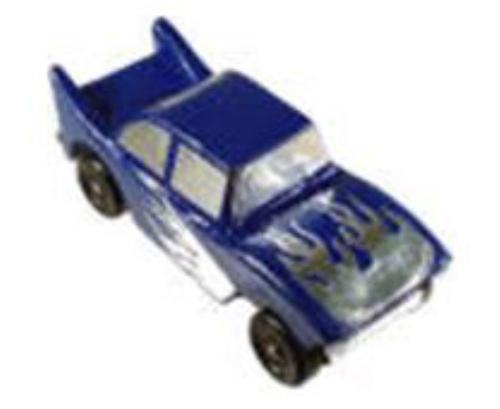
Welcome Racers, Parents and Leaders
These pages are a collection of Pinewood Derby information combined with specific information about the Pack 408 and the White Buffalo District derby races.
The first Cub Scouts to participate in a Pinewood Derby were from Cub Scout Pack 280c of Manhattan Beach, Calif. The event was originated by Cubmaster, Donald Murphy, and was run in the Manhattan Beach Clubhouse on May 15, 1953.
This event was later publicized in the October 1954 issue of Boys' Life, with the magazine offering plans for the track and car (which featured four wheels, four nails, and three blocks of wood).
What is a Pinewood Derby?
A bunch of fun! At the end it is a Pack of Cub Scouts racing little wooden cars of various shapes and colors on little plastic wheels down an inclined track. But that is only a small part of it. Each Cub Scout gets a kit with a block of wood, four nails for axles, and four plastic wheels. Then, based on the rules, he shapes and paints his block or wood into a form to race down the track.
Our Pack divides the races into Tigers, Wolves, Bear, Webelos I, Webelos II and "OUTLAW", the Pack awards a trophy to the top three cars for each race. The "OPEN" race is open to everyone. The Scout's siblings and parents always enjoy this race.
The hard work and dedication of our Pack's parent volunteers have made this event a favorite for the Scout's of Cub Scout Pack 408.
Yours in Scouting,
Pack 408 Pinewood Derby Committee
|
|
Cub Scout Pack 408 Pinewood Derby - Principals
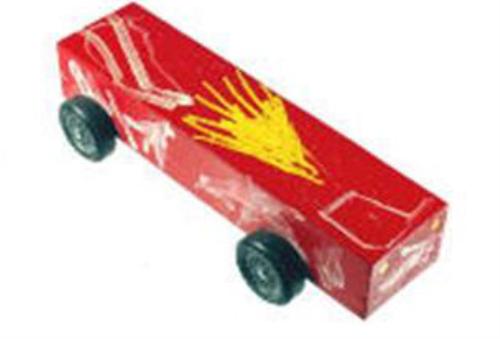
Principle 1: Have Fun!
The sole purpose of this event is for the Scouts and families to have FUN. This is the first and most important principal. Spend some time with your Scouts and build something together that will REALLY last...great memories!
Principle 2: Cub Scouts - Do your best
Designing, constructing, and racing a car is a joint effort between a young person and a mentor. Obviously, there are some jobs that some young people cannot perform adequately or, more important, safely. But if the young person has the skill or can learn the skill, then let the young person exercise the skill. You'll both probably learn more that way.
For younger scouts be sure to keep the "core" shape of the car simple. Let your scout personalize the car by adding balsa wood - which they can cut and shape easily. In addition, they can personalize the car with paint, stickers and other decorations (e.g., LEGOTM parts, pieces from broken toys, craft store adornments).
Coaching Hints for Parents
Help your son plan a schedule to prevent a last minute project and allow time for him to do his best.
- Help your son understand the Pack rules and specification requirements.
- As your son chooses his favorite design, help him trace it on the block of wood from the kit. Guide him in the use of tools in the shaping of the model and encourage him to sandpaper the model to a smooth finish.
- Help your son feel that this is a joint project, with him doing much of the work.
- Help your son understand that "doing your best" is more important then having the fastest car.
- Feel a sense of pride and satisfaction when the model and race are finished. Share it with your son. You have both earned it.
- Understand that the leaders may need your help. If you have the interest and the time, you might contact the leaders and volunteers to help.
- Spending time with your son, helping him "do his best" will be remembered by both of you long after the race is finished.
- Talk to your son about the race and the importance of good sportsmanship.
Principle 3: Performance and beauty are often opposites.
Everyone would like to simultaneously optimize for both speed and beauty. Historically the simplest cars always appear to be the quickest. So, it is important to consider whether you want a fast car or to win a design award. Very few cars have won both.
Principle 4: Maximum weight enables maximum speed.
Get the car's weight as close to five ounces as possible. The easiest way to address this is to drill holes or mill out space to add weight to the car at the registration weigh-in.
Most folks agree that having the weight shifted to the back is best. However, if too much is shifted to the back the car tends to do a wheelie. This leads to a car that is directionally unstable. You cannot win a race if your car cannot stay on the track.
Principle 5: Little things DO matter.
Taking time to polish the axles and to smooth the wheels can make a significant difference in how fast the car is on the track. Wheels with high spots produce a bumpy ride, causing loss of time and might cause the car to leave the track, possibly resulting in major damage.
In addition, getting the wheels and axles on the car straight is absolutely critical. Some people recommend using a drill press to push a sacrificial axle in place and others suggest using pieces of wax paper (or regular paper) to carefully shim the wheel straight. All of the various approaches can work given that you take your time.
Set enough time aside to get the wheels straight.
Consider a few practice runs at the local hobby shop test tracks.
Lastly, be certain to set aside time for the paint to thoroughly dry. Paints can remain gummy and tacky for days.
Principle 6: Remember the rules.
Follow the rules. If you can't pass inspection, you can't race. No one wants anyone to spend hours building a car that cannot race. In addition, last minute "fixes" can lead to big problems and should be avoided as much as possible.
Assure that you have adequate ground clearance. You can do this by rolling your car over five stacked nickels (the car straddles the center rail as it runs down the track). Failure results in either grinding to a stop part way down the track or flipping off the track as a high spot is passed. If you can't get to the finish line, you can't win!
Assure that the car will "run" on the track. A narrow or pointed nose may not stage correctly on the starting mechanism and may not trip the finish line sensor correctly (might lose a race you may have otherwise won).
|
|

The purpose of these rules is to provide a reasonable and level playing field for all contestants for all races. If you still have uncertainty about what is allowed, please contact the Derby Committee.
ELIGIBILITY OF CONTESTANTS AND CARS
- The Pinewood Derby Scout competition is open to all Pack 408 Cub Scouts. In case of illness or a valid conflict, an absent Scout may be represented by an authorized agent.
- An authorized agent is defined as a sibling or a Cub Scout of similar age who is not already competing in the same set of heats.
- Cars in the Pack 408 competition must have been made for this race season. Cars or parts of a car (such as wheels or axles) from a previous year are prohibited.
- This is an official Scouting event. WEAR YOUR UNIFORM.
- Cars in the Pack 408 competition must be built from the block in the official Grand Prix Pinewood Derby kit. Other car kits may not be used. "Pinecar" kits, wheels and axles sold at hobby shops are NOT allowed (Pinecar weights and decals are allowed).
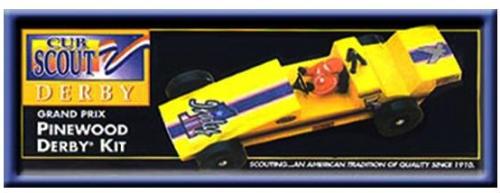
Design Rules
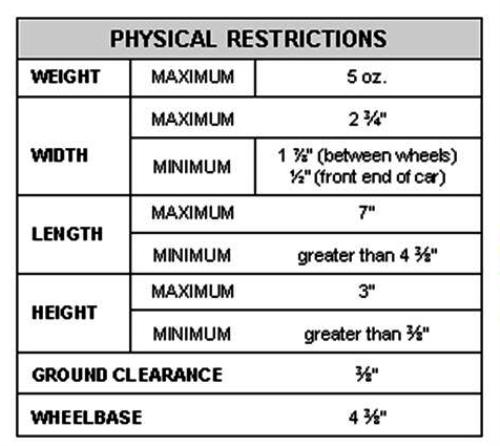
CAR SPECIFICIATIONS
- Weight: The weight shall not exceed 5 ounces (or 141.75 grams). The readings of the Official Race Scale will be considered final.
- Distance Between Wheels: Side to side = 1 ? inches. This allows the car to travel down the guide strip on the track.
- Distance Between Axles: Front to back = 4 ? inches, consistent with the Official BSA kit dimensions. This distance cannot be altered.
- Ground Clearance: Minimum clearance between the bottom of the car and track shall be ? inches so the car will clear the center guide strip. The car should roll over 5-stacked nickels.
- Car Length: Maximum length (including wheels) shall not exceed 7". Car length must be greater than 4 ? inches (see wheelbase restriction).
- Wheelbase: The wheelbase (distance between the front and rear axles, center to center) may not be changed from the kit body distance of 4 ? inches. The official kit block has pre-cut slots which are correctly spaced. If desired, these slots may be pre-drilled before they are used. Use of the pre-cut slots, however, is not required.
- Overall Height: The overall height must not exceed 3".
- Overall Car Width: Maximum overall width (including wheels and axles) shall not exceed 2 ¾ inches.
-
- Width at the forward most part of the car must be at least ½". If the car fails this test, then the car will be run backwards, providing that the width at the back most part of the car is at least ½". If the car fails both conditions, then it will be disqualified.
CAR DETAILS
- Attachments Allowed: Details such as drivers, side pipes, roll bars, steering wheels, air spoilers, decals, open fenders and additional weights are allowed. Said attachments must be securely attached and without moving parts. Attachments must meet all car specifications rules stated in the Car Specifications section (above). Be sure any weights that may be added do not interfere with the ground clearance. Weights should be put in the car, not on the car.
- Accessories: Additional materials may be added to the car for the following purposes only.
- Mill or carve out the bottom of the car for a spot to add weight before any carving is done to the top surfaces. It is much easier when the block is square but almost impossible after painting and wheel assembly.
- Weights may be added to increase the weight and/or alter the weight distribution of a car.
- Paints/decals/decorations may be added to alter the appearance and/or aerodynamics of a car (excluding the wheels).
- Wood putty, or a similar wood-like substance, may be used to repair minor damage to a car.
- Attachments Not Allowed: Items such as washers or decals between the wheels and the body, wheel bearings, bushings, springs, starting devices, hubcaps, full wheel covers, or full fenders covering the nails, which impedes the inspection process. If additional weights are added, they must be securely attached and have no loose or moving internal parts.
- Starting Gate: The track starting gate is ½ inch wide. A sharp pointed car design, such as a pencil, may not align itself correctly against the starting gate. A "chisel" point of at least ½ inch wide (or more) is recommended. A car that has a "U" or a "Y" front design will be ran backwards, in order to insure a correct start. At no time shall any portion of the car extend past or over the starting gate. All cars must start from a standing still position.
- Finish Line: The track has an electronic finish line. This device emits a light beam approximately the diameter of a pencil. It is recommended that the car does not have a front that comes to a sharp point. A sharp pointed car may not trigger the electronic finish line correctly.
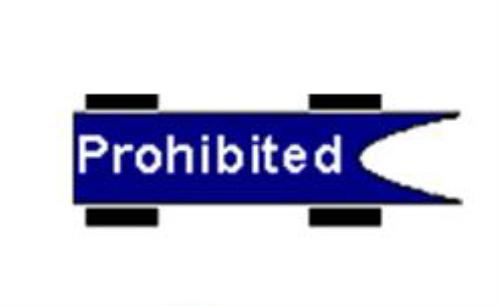
WHEELS & AXLES
- Wheel Modifications: Only the wheels and axles from the official Grand Prix Pinewood Derby kit may be used. Wheels and axles not from the official kits are prohibited. Wheels and axles that have been modified by other parties also are prohibited, even if they are from the official kit. They may NOT be painted. It is recommended that the wheels be lightly sanded to obtain as flat of a surface as possible. Wheels with high spots produce a bumpy ride, causing loss of time and might cause the car to leave the track, possibly resulting in major damage. NO OTHER WHEEL MODIFICATIONS ARE ALLOWED.
- Essentially, the only change to the wheels allowed is the removal of the burr left from the molding process. Wheels must be full width, as provided in the kit. Wheels must not be
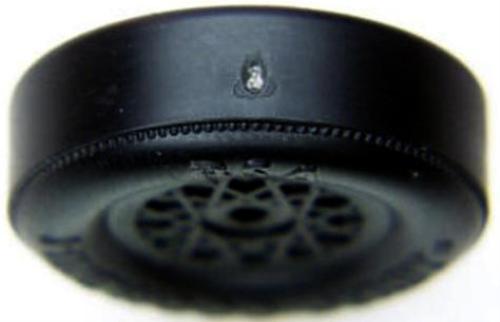
- tapered or re-formed to reduce the "footprint" of the wheel on the track.
- WHITE BUFFALO DISTRICT RULES REQUIRE ALL FOUR WHEELS MUST HAVE AT LEAST 90% OF THE WHEEL TREAD IN CONTACT WITH THE TRACK AT ALL TIMES. CARS WITH ONE RAISED WHEEL MUST BE MODIFIED TO CONFORM TO THIS RULE, OR WILL NOT BE ALLOWED TO RACE. The Pack 408 PWD Committee interprets this rule as follows: The car must have all four wheels move at least once when the car is rolled on a flat surface over a distance of 4".
- Axle Modifications: The axles provided (nails) in the official BSA kit must be used. Sanding the axles to remove the die seams that are a result of the manufacturing process is recommended. Polishing the axles with toothpaste or jewelers' polishing compound is good idea. Chroming, or any other type of special technical process will not be allowed. To reduce the diameter of the head of the nail, in order to minimize friction will be allowed - within limits. To reduce the size of the head of the nail by more than 25% will be considered extreme and will not be allowed. Significant beveling, rounding, tapering, thinning, perforating, or any other significant altering of the shape or performance of the axles or axles heads is prohibited. Axles must be mounted into the wood. All suspect nails will be measured by an inspection official, and if less than 75% of the head remains, it will be disqualified. This procedure, as well as any chroming process, is considered beyond the scope of a Cub Scout aged boy.
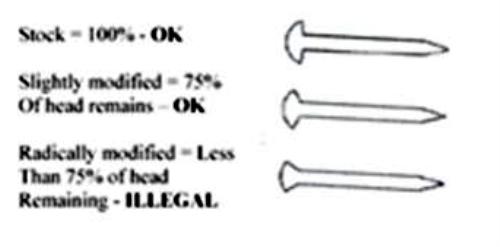
- Lubrication: A dry lubricant such as graphite, or the BSA white dry lubricant (powered Teflon) is allowed. Some oils are caustic to the plastic wheels, causing damage. Therefore, all "wet" lubricants are not allowed. The lubricant should be applied to the wheel hubs, axles (nails) shafts/heads, and all other contact points where the wheel touches the body of the car. Lubrication cannot be applied after the car has been registered. Dry graphite is a messy material. Please do not bring this material into the building. When spilled, it is impossible to remove from the floor, and is a potentially dangerous substance, if ingested. Please apply the lubricant at home, under adult supervision, or outside in the parking lot. It is helpful to "work in" the dry lubricant, by spinning the wheels, often. A car can only be lubricated prior to confiscation. Cars may not be lubricated while competing in a set of heats.
- No Bearings or Washers: Wheel bearings, washers, or bushings are prohibited. This includes "wheel covers" which serve to keep the wheel hubs from contacting the car body. It also includes "hub caps", or anything else that might serve as a lubrication "well" or "tap". The car shall not ride on any type of springs. The car must be freewheeling with no starting device or other propulsion, such as adhesives, magnets, rubber bands, motors, etc. Metal frames and metal axle supports are prohibited.
GROUND RULES
- If a car leaves its lane and interferes with another car, the heat will be run again. If the same car leaves its lane a second time and interferes with another car, the heat will be run again without the interfering car. The interfering car will automatically lose the heat.
- If a car suffers a mechanical problem and a repair can be accomplished within 5 minutes, the heat will be run again. If not, the car will automatically lose the heat.
- If a car does not "stage" correctly, that is fit on to the starting gate correctly because the car has too narrow of a nose, or the front is modified as to "ride up" the starting gate because the front has too steep an angle, it is the official district starter's option to run the car backwards to insure a correct start. If the car has a split front end, a "Y" or "U" front end design, the car will be ran backwards.
- IT IS EXPECTED THAT EVERYONE CONDUCT THEMSELVES IN A CIVIL AND SPORTSMAN LIKE FASHION AT ALL TIMES. ANYONE FOUND NOT ADHERING TO ALL OF THE OFFICIAL RULES WILL NOT BE ALLOWED TO RACE. THE DECISIONS OF THE PACK 760 RACE OFFICIALS ARE FINAL .REMEMBER, WE ARE HERE TO HAVE FUN, NOT TO DECIDE THE FATE OF THE WORLD.
- Ungentlemanly or unsportsmanlike conduct by any participant or member of the audience will be grounds for expulsion from the competition and/or race area.
REGISTRATION, INSPECTIONS & DISPUTES
- Each car must be clearly numbered with the number assigned when the car is enter at registration.
- Each car must have the name of the Scout clearly noted on the bottom (to ensure names do not interfere with design judging).
- Each car must pass inspection by the Official Inspection Team before it may compete. The Inspection Team has the right to disqualify those cars that do not meet the rules. Car owners will be informed of the violations and given an opportunity to modify the car to meet these rules.
- Cars will be impounded when registered. After the car has been certified legal, no other modifications will be allowed, such as adding additional lubricant and/or weight. Registration will occur at NorthWest Christian Church. There will be one registration session. Please check the Pack calendar for the date and time.
- In order to be eligible for the racing awards, the Scout's cars must be registered during the registration period.
THE COMPETITIONS
- Scout racers will be divided into TIGER, WOLF, BEAR, and WEBELOS I and WEBELOS II divisions. First, Second, and Third place trophies will be awarded in each division.
- Remember, this is an official Scouting event. WEAR YOUR UNIFORM.
- An Outlaw race, open to anyone, will also be run. All rules spelled out in this document apply.
- The judges will be selected by the Pinewood Derby Committee and will be instructed on how to judge each category. Specifically, the judges will be instructed to take into consideration that the vehicle should be primarily the work of the Scout.
- The Outlaw race will also have awards (First, Second, Third) Outlaw cars can be raced by builder or any assigned designee.
- The first place winners in each RACE division (excluding the OUTLAW race) will automatically be entered in the White Buffalo District Pinewood Derby race (scheduled for Saturday, March 30th). If for some reason, the first place finisher cannot compete, please inform the Pinewood Derby Committee Chair so that Pack 408 can be represented in the White Buffalo District Pinewood Derby race.
|
Design Hints
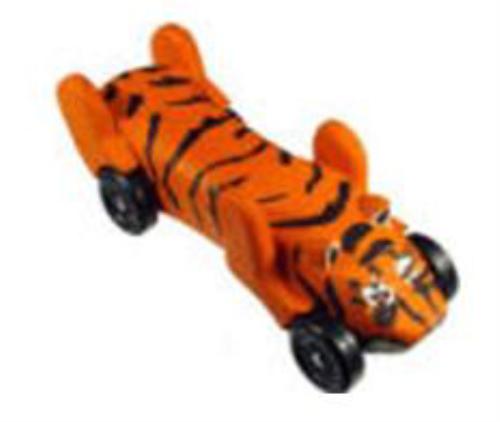
Cub Scout Pack 408 Pinewood Derby
Designing
There are two things to think about went you begin designing a Pinewood Derby car. The first thing to think about are the dimension restrictions in the rules. The second is planning ahead for adding weights to the car.
Be certain to mill, carve out, or drill holes in the car to set aside a place to easily add weights. It is much to easier to drill or mill out space when the block is square but almost impossible after painting and wheel assembly. In addition, failure to plan space for weights at the in the design process has often lead to last minute damage at the registration weigh-in.
Have the Scout do the design of the car. An easy way to help them is trace the block of wood on a piece of paper and have the Scout trace the outline of the car they want to build. Be sure to point out the maximum height and wheel locations.
- Have them select a favorite toy car (Matchbox or Hotwheels cars work really well for this.)
- Trace the shape of the pinewood derby block onto a piece of paper. Be sure to do the side, back, and front views.
- Have the scout look at the car, and sketch its outline onto the paper, modifying it as necessary to fit in the pinewood derby block shape.
- Kids will usually need to try a couple different times to get it just right.
- Finally, have them cut out the paper and tape it to the block. The paper will work as a template for sawing.
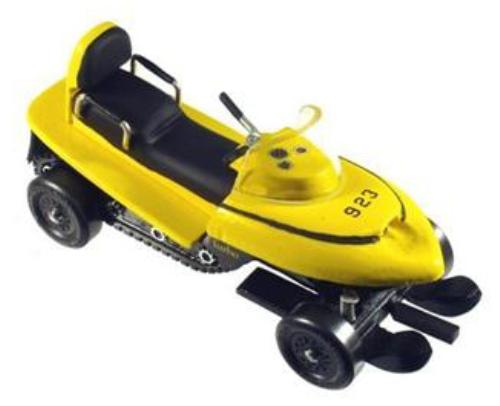
|
Welcome to Pack 408's speed hints page. This is by no means a comprehensive listing of everything that you can do to speed up your car. We will leave the wind tunnel testing for others to complete. What we have attempted to do is to provide some practical hints that can enable Scouts to build competitive cars. If you have any ideas or suggestions send them to the Pinewood Derby Committee.
1 - Designing
There are two things to think about went you begin designing a Pinewood Derby car. The first thing to think about are the dimension restrictions in the rules. The second is planning ahead for adding weights to the car. For more help with designing your car take a look at our Design Hints page.
2 - Rules
Understand and follow the rules. The fastest car can't win if it never gets a chance to race.
3 - Weight
You may or may not remember your high school physics (or if you are a Scout you can look forward to them) but the principals of Potential Energy and Kinetic Energy were described. The bottom line is that the heavier the car the faster it may be able to go the track (depending on friction). One of the most significant things you can do to ensure that your car is competitive is to ensure that it comes in at or very close to 5 oz. To get the average car up to 5 oz. you will likely need to add 2 or 3 ounces of weight to the car. But where on the car do you add the weight?
Plan ahead where to place the weights. Be certain to mill, carve out, or drill holes in the car to set aside a place to easily add weights. It is much to easier to drill or mill out space when the block is square but almost impossible after painting and wheel assembly. In addition, failure to plan space for weights at the in the design process has often lead to last minute damage at the registration weigh-in.
Anything can be used to add weight to a car so long as the weight is fixed and securely attached to the car. However there are some preferred methods the "Pros" use to bring the car up to maximum weight.
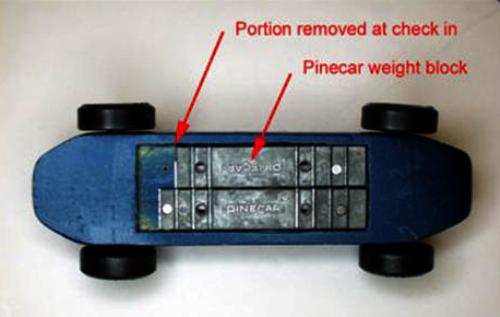
Pinecar Weight Blocks: these are perfectly legal and can be purchased at local hobby shops. They are made of a relatively safe lead alloy and can be screwed into a pre-formed pocket on the bottom of the car. The method is to show up at check in with the car slightly over 5 oz. After the first weight check, parts of the weight block can be broken off to bring the car to legal weight.
Lead Tape Weights: Available at local hobby shops. These are generic lead weights with sticky foam tape on the bottom. The mass of these weights is greater then the Pinecar Weight Blocks so they can take up less space. They can be stuck to the car as is or with hot melt glue. The method is to show up at check in with the car slightly under 5 oz. After the first weight check, additional pieces of weight block can be added bring the car to legal weight. These weights should be handled with appropriate care as they do contain lead.
Lead Fishing Bullet Weights: Available at local sporting goods stores. These weights come in various sizes and weights (typically 1/16 oz and 1/32 oz). They can be used to fine tune an underweight car to the maximum allowable. The method is to show up at check in with the car slightly under 5 oz. After the first weight check, the bullet weights can be pressed into predrilled holes in the bottom (or side) of the car. A touch of hot melt glue secures them in place. Pre-drilling means putting the holes in before the car is painted...adding the holes at check in is almost impossible with out damaging the car. These weights should be handled with appropriate care as they do contain lead.
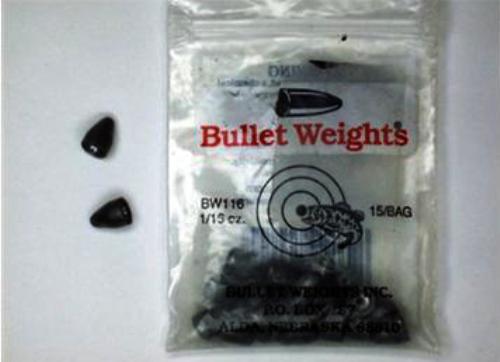
In regards to where you should locate the weights, you achieve the highest potential energy by adding weight towards the rear of the car as high as practical. It won't make a huge difference but then every little bit helps. The theory is that the higher weight pushes the car for a longer period of time.
Please keep in mind this can be overdone, but a simple test to make sure the car is properly weighted is to balance the finished car on a pencil. The car should balance somewhere in front of the rear axle. Otherwise, the car will to tend to do wheelies and won't necessarily go straight down the track. The track section joints can provide a significant jolt to the car. This can make the car's front wheels jump up, maybe even enough to derail it from the track.
4 - Axles
The axles provided (nails) in the official BSA kit must be used. The "nail" axle out of the box may look to be in good shape. Do not let the fact that it may be bright and shiny deceive you. If you look carefully you will see at least two metal flashing "webs" between the nail head and the shaft. Sanding the axles to remove the die flashing material that are a result of the manufacturing process is recommended. These small metal "webs" can cause a lot of friction if they are not addressed.
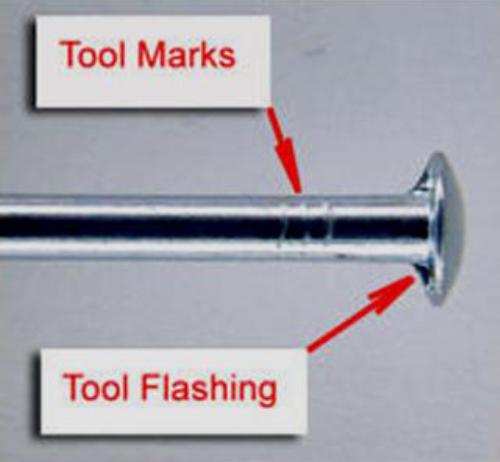
Mount the axle in a drill motor or drill press and to perform file and polish these webs away. Use a file and/or sandpaper with water or light oil to polish them. Use 600 grit sandpaper or finer. Polishing the axles with toothpaste or jewelers' polishing compound is good idea. Axles should be polished smooth to make certain that the wheels can roll with minimal friction.
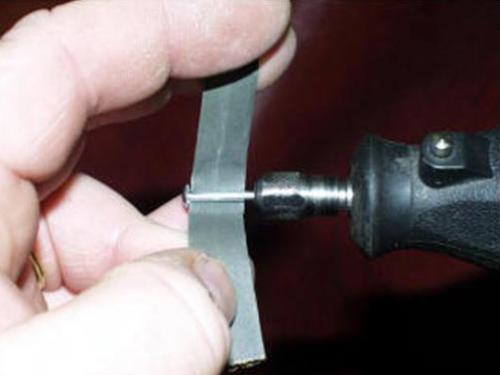
Chroming, or any other type of special technical process is not allowed. To reduce the diameter of the head of the nail, in order to minimize friction is allowed - within limits. To reduce the size of the head of the nail by more than 25% is considered extreme and is not permitted. A properly finished axle should look like this:
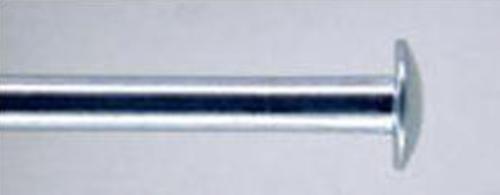
Significant beveling, rounding, tapering, thinning, perforating, or any other significant altering of the shape or performance of the axles or axles heads is prohibited.
In addition, keep in mid that the axles must be mounted into wood.
5 - Wheels
Imperfections in your wheels cause friction in many areas. Sanding your wheels, however, can be tricky. If the wheels are not precision sanded or lathed, you can actually make matters worse!
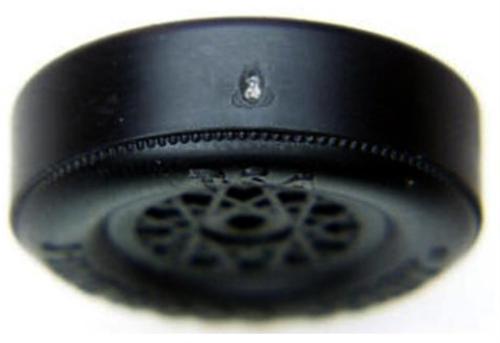
A wheel sanding mandrel can be used to help sand the injection burr off the wheel. They can be found at local hobby shops. The mandrel is mounted in a drill motor or Dremel rotary tool. The mandrel can check for a wildly malformed or warped wheel. BE CAREFUL!! It is incredibly easy to melt the surface of the wheel when high speeds are combined with a little pressure. Many a wheel have been destroyed with these mandrels. Use 600 grit paper at a slow speed to start.
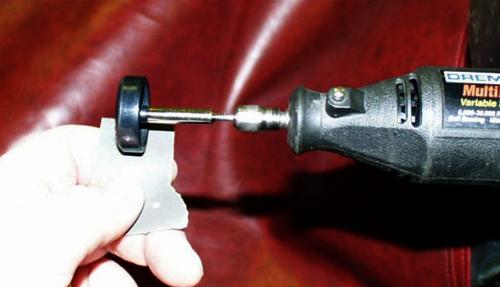
A properly polished wheel should look like the following:
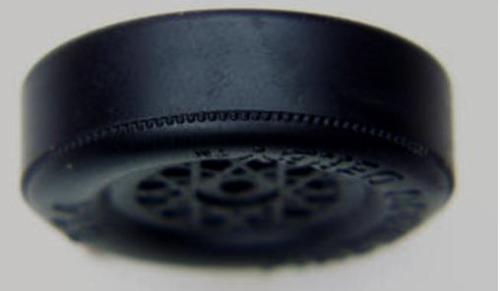
Insure your wheels roll smoothly and are not binding. A good test is to spin each of your wheels with your finger and let them run to a stop. It should take 20-30 seconds for well tuned and lubricated wheels to stop completely. You will want to rub some dry graphite on the surface of the car body where the inner wheel hub touches. You can't use washers so minimize the friction of these rubbing surfaces. Another trick is to rub the entire surface of the wheel with graphite too. Messy, but it doesn't hurt.
Wheel bearings, washers, or bushings are prohibited. This includes "wheel covers" which serve to keep the wheel hubs from contacting the car body. The district also prohibits "hub cap" decals or anything else that might serve as a lubrication "well" or "tap".
Examples of ILLEGAL WHEELS:
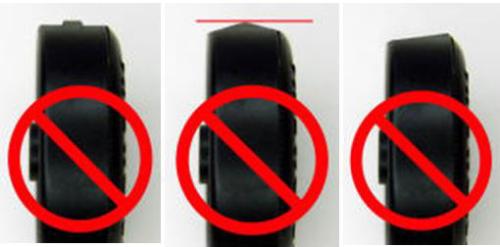
Examples of finished wheels that are legal for use:
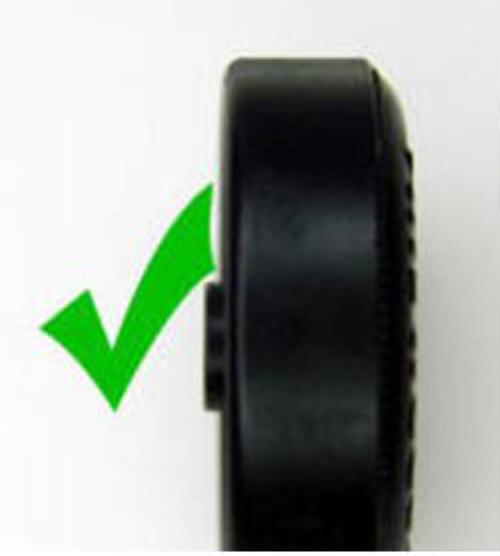 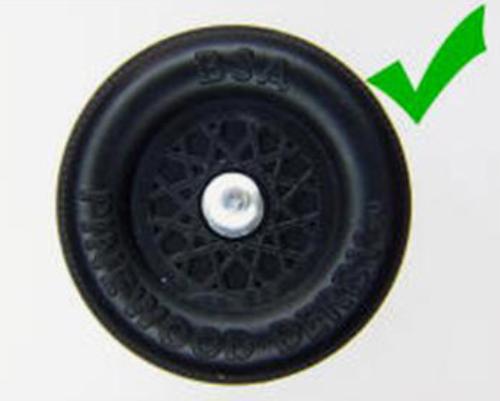
6 - Straight
Insure that your car is tracking straight. A car that bumps the lane guide more often gets slowed down more often. A "front-end alignment" may be necessary. The slot is fine for installing the wheels but ensure your cuts are absolutely square to the car body. You can also drilled holes into the body (flipping the block upside down) but make sure they are also drilled at the same distance from the bottom of the car (impacting ground clearance) and that you do not modify the distance between the wheels (see rules for the specific tolerances).
One method to assist in getting the wheels inserted straight is to sacrifice an axle, cut off the head and use a drill press to insert 80% into the car. This significantly helps in getting the axles in square.
Always check the car by rolling it along a smooth clean surface. If it veers to the right or left too much, the axles are crooked. Just like steering a car, you need to adjust the steering on your car. To do this, you must adjust one or more of the axles so the car rolls straight. You can do this by re-drilling the axle holes and re-inserting the axles.
There are a few different alignment procedures, and they vary depending on the use of axle slots or holes. The best procedure is to use shims made from wax paper to adjust the alignment. This can be a long, time consuming and often frustrating part of the build - set aside the time to get it right.
7 - Lubrication
Use a good dry lubricant. Dry graphite seems to work better than the white Teflon compounds now available.
A dry lubricant such as graphite, or the BSA white dry lubricant (powered Teflon) is allowed. Some oils are caustic to the plastic wheels, causing damage. Therefore, all "wet" lubricants are not allowed.
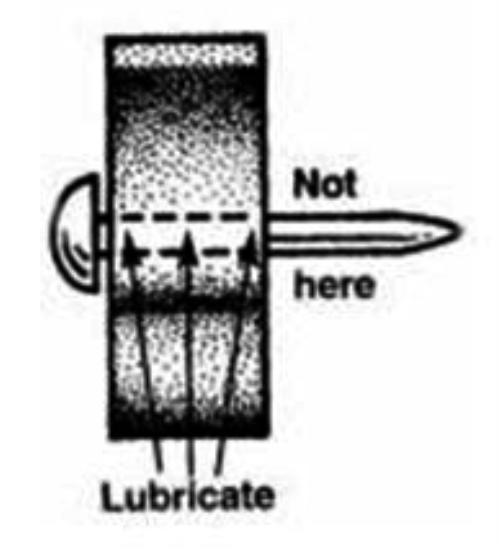
The lubricant should be applied to the wheel hubs, axles (nails) shafts/heads, and all other contact points where the wheel touches the body of the car.
Dry graphite is a messy material. Please do not bring this material into the building. When spilled, it is impossible to remove from the floor, and is a potentially dangerous substance, if ingested.
Please apply the lubricant at home, under adult supervision, or outside in the parking lot. It is helpful to "work in" the dry lubricant, by spinning the wheels, often. A car can only be lubricated prior to confiscation. Cars may not be lubricated while competing in a set of heats.
8 - What not to do
Never roll your competition pinewood car on the ground or concrete. These rough and dirty surfaces can ruin the car's wheels, axles and alignment.
Don't waste a lot of money on all the elaborate tools you can by for pinewood derby cars. Basic household tools are more than adequate. Ask a Den Leader or contact the Pinewood Derby Committee if you need help or do not have adequate tools.
Don't ruin a good thing. If you build an adequate car that can roll straight don't spend too much time making it "better". The final cars are often quite fragile. If you spend too much time attempting to make it "perfect" you can damage it. Changes can sometimes work in the reverse of the best intentions.
|
|
|
 |
 |
|
 |
 |
 |
 |
|
|
|
|
|
|
|
|
|